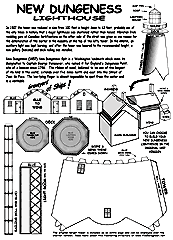
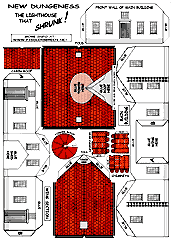
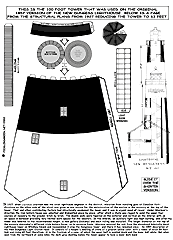
New Dungeness Lighthouse, New Dungeness, Washington
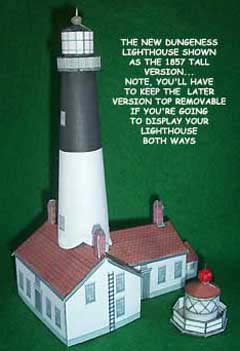
From Port Angeles the coast trends east for 13 miles to the end of Dungeness Spit which encloses picturesque Dungeness Bay. The bay offers shelter in the west winds but is open to the east, a dangerous place in winter gales. The bay is formed by a sandpit extending northeast four miles and forming, in addition to Dungeness Bay, a small lagoon at the head of the harbor for light-draft vessels only. New Dungeness Light marks the area at the outer end of the spit shining seaward from a 63 foot tower. A foghorn and radio beacon are also at the site.
Nowadays the tower is only about half as tall as it was 140 years ago. Suffering from structural weakness, the original structure was in danger of collapse by the late 1920s. To save it engineers decided to take some of the strain off its walls by lopping thirty-seven feet off the top.

New Dungeness Lighthouse (1857)
 The lighthouse and the spit on which
it stands took their name from Dungeness Point in England, coincidentally
famed for its magnificent lighthouse. Like its British namesake,
Dungeness Spit is a ship killer. The list of vessels wrecked on
its sands is nearly endless.
The lighthouse and the spit on which
it stands took their name from Dungeness Point in England, coincidentally
famed for its magnificent lighthouse. Like its British namesake,
Dungeness Spit is a ship killer. The list of vessels wrecked on
its sands is nearly endless.
The New Dungeness Light originally stood LESS than 900 feet from the end of the spit that it guards. Today the distance has increased several times. Naturalists explain that the pennsula continues to grow as, each year, fifteen to fifty feet of sandy deposits accumulate around the tip..
New Dungeness (1857) New Dungeness Spit is another prominent Washington landmark which owes its designation to Captain George Vancouver, who named it for England's Dungeness Point, site of a beacon since 1746. The protracted ribbon of sand, believed to be one of the longest of its kind in the world, extends more than five miles north and east into the Strait of Juan de Fuca. The low-lying finger is almost impossible to spot from the water and has always been a dreaded peril to sailors.
The federal government recognized this important location during
its earliest deliberations to establish lighthouses on the West
Coast. The 1848 Congressional act which created the Oregon Territory
(including present-day Washington) also called for lighthouses
at Cape Disappointment and New Dungeness. They, together with
ones at Willapa Bay and Smith Island, were among the initial group
of sixteen Pacific coast lights ultimately selected for construction
between 1852 and 1858.

Work on the New Dungeness site languished for several years, after the Treasury Department reallocated the money appropriated to build the light (and several others) and funneled it into other projects. Construction eventually began in 1857, and the lofty beacon was officially lit on 14 December, making it the first established Washington lighthouse north of Cape Disappointment (at the mouth of the Columbia River).
The 90-foot lighthouse rests on a foundation of giant sandstone blocks, necessary to provide stability atop the sandy undersoil. The conical tower was likewise crafted of sandstone, overlayed with stucco and topped with a white lantern and red roof. The upper half of the structure, rising through the roof of a two-story brick house, was then painted black and the lower half, white.
Over time, cracks appeared in the upper portions of the light tower. In 1927, the Bureau of Lighthouses had the upper third of the structure removed and atop the remaining portion installed the lantern and fourth-order lens from the no-longer-active Admiralty Head Light. This classic optic is now on display at the Coast Guard Museum/Northwest, in Seattle.
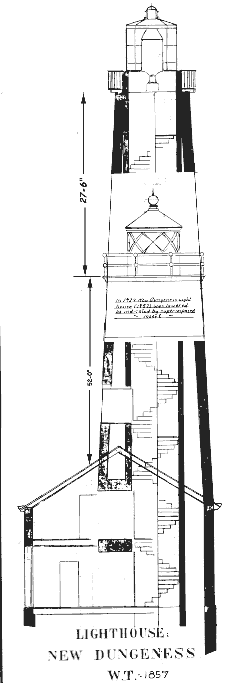 The Coast Guard removed the last New Dungeness keeper in 1994
and talked about boarding up the station. That year, a small group
of preservation-minded citizens formed the New Dungeness Chapter
of the US Lighthouse Society and obtained a five-year renewable
lease on the lighthouse and grounds. To keep its agreement to
preserve the station, the chapter rents the (1904) house on a
weekly basis to two families of "keepers. who are responsible
for doing the necessary upkeep and maintenance and conducting
tours for visitors
The Coast Guard removed the last New Dungeness keeper in 1994
and talked about boarding up the station. That year, a small group
of preservation-minded citizens formed the New Dungeness Chapter
of the US Lighthouse Society and obtained a five-year renewable
lease on the lighthouse and grounds. To keep its agreement to
preserve the station, the chapter rents the (1904) house on a
weekly basis to two families of "keepers. who are responsible
for doing the necessary upkeep and maintenance and conducting
tours for visitors
Congress agreed to alot funds for beacons at both Cape Flattery and New Dungeness, but construction was not authorized until $39,000 was made available in August 1854. Once given the green light, a Coast Survey crew under George Davidson landed on the little island and chose and suitable spot for the lighthouse at the highest elevation, 100 feet above the Pacific. He noted the place had neither a source of wood or water and that the Makah Indians frequented the island in large numbers especially during the summer to catch salmon and to spear whales. Additionally they planted potatoes on the 20 acre plateau. Only one landing site was available.
Without thought of compensation to the Indians, plans proceeded for this their favorite Summer retreat.
With the arrival of the construction crew there were fears of an Indian uprising. George Davidson who had headed an earlier survey party reported that his mission "has been executed at the risk of the life of everyone at work on it. The only means of conveyance I could furnish was two small canoes which were forced to land on the rocks and at rocky points... I consider the station to have been occupied at very great risk from the hostility of the Indians; but a knowledge that we were always prepared for an attack, without doubt, prevented one. We built a breastwork and could fire 60 rounds without reloading. Guard was kept six hours every night."
At the time of his report, 150 Indians were on the island and there was tension and agitation among the tribesmen over the unwarranted invasion. Davidson's findings were backed by the further reconnaissance with the arrival of the survey steamer Active in 1853. The Makahs were bitterly disturbed during that summer after a widespread smallpox epidemic broke out claiming the lives of nearly half of the 1,000 members of the tribe. They blamed the "Bostons" for the dreaded disease and were in a mood for revenge, prompted even more by the takeover of Tatoosh.
To add to the friction, the warlike Haidas arrived in the area
in 40 of their big canoes, disguised as traders. They, like the
Noresmen, were hit-and-run warriors. With the presence of the
well-armed Active however, things remained under control. The
loud reports of the ship's cannon in gunnery practice put a damper
on the hostile plans of the 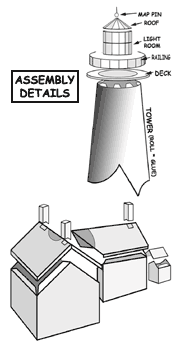 Indian tribes.
Indian tribes.
Superintending the construction of both Cape Flattery and New Dungeness Lighthouses, was Isaac Smith. Among the building materials he acquired were huge blocks of dressed sandstone from the Bellingham area, blocks measuring two feet in thickness. By 1855, construction work was well underway, but with the difficulties encountered, it required a year and a half to complete the station. Curious and often abusive Indians milled about, occasionally stealing tools and being generally obnoxious which necessitated the erection of a blockhouse in which 20 muskets were stored for protection should a sudden uprising occur. The construction schedule was lagging due to delays caused by inclement weather and the slow arrival of materials.
Collector of Customs Morris H. Frost who was in charge of aids to navigation, asked for assistance from the lighthouse authorities in protecting the building materials during the winter because of the bitter attitude of the natives. Smith meanwhile rallied his laborers to speed up the work and cited competition with the construction crew at New Dungeness Lighthouse, virtually pitting the respective teams against one another to see which lighthouse would be the first to be lighted. The challenge spurred the men to a greater effort. The light was commissioned December 28, 1857, just 14 days later than New Dungeness, yet considering the fact that the beacon was on an island and that the transport of building materials and personnel was more difficult than at the other station, it was a moral victory worthy of merit.
During its early years the light guided not only ships and fishing vessels but canoes paddled by Indian warriors prepared to do battle on the spit. Traditionally, tribes living on opposite sides of the Strait of Juan de Fuca would meet on the spit to settle their differences. After the lighthouse was built, they continued the practice, but now their meeting place was much easier to find. Apparently happy to have a light to guide them to their dark and bloody work, the war parties never molested the keepers-only one another.
Click this link to get a look at New Dungeness Lighthouse right now from the Webcam of the lighthouse funded by donations in memory of former NDLSA President Joel Magisos.




